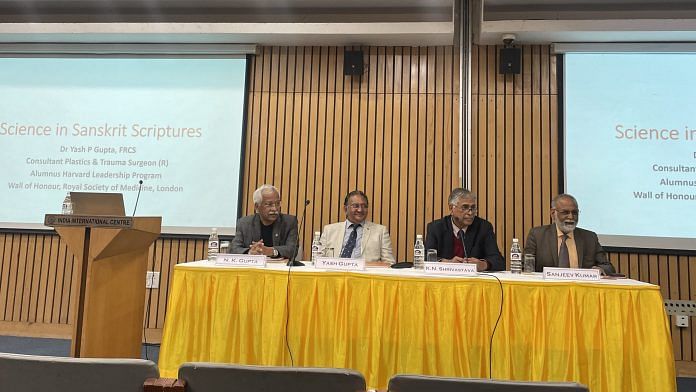How an accomplished man of medicine found his true calling in the world of ancient Indian scriptures is what had the rapt attention of about 30 people on a cold evening in the heart of Lutyens’ Delhi. Tales of plastic surgery, the circle of life, and several Sanskrit shlokas were discussed and correlated. Dr Yash Gupta, senior plastic and trauma surgeon, an Oxford University alumnus, held a discussion over his new book Science and Scriptures, which was released earlier this month.
Hailing the vastness of India’s ancient scriptures as all-encompassing and profound, Dr Gupta talked about how he chose to join the dots between science and his cultural roots.
With 10 years of research work backing it, Science and Scriptures covers various Sanskrit verses that supposedly talk about atoms and time, math and the concept of zero, aircraft and spaceships, medicine and surgery, and the Kali Yuga.
Constantly glorifying the Sushruta Samhita — an ancient Sanskrit text on medicine and surgery, heavily referenced in his book — Dr Yash said: “The entirety of the text sounds nothing less than a present-day MBBS syllabus.”
Dr Naresh Gupta, consultant and advisor at Maulana Azad Medical College, joined Dr Sanjiv Kumar, chairperson of Three Domain Health Leadership Foundation as a panellist, while K.N. Srivastava, director at Delhi’s India International Centre, moderated the discussion. Graduates of Delhi’s All India Institute Of Medical Sciences (AIIMS) occupied the dais, sharing laughter, humour, recalling college memories, and congratulating their friend Dr Gupta.
The question they tried to answer was — Can we reconcile scriptures and modern science? One is the old world of ancient medicine, still so deeply rooted in culture, and the other an approach that defies it all. Doctors, journalists, authors, and professor and former Indian diplomat K.P. Fabian also attended the discussion.
Also read: Indian scholar at Cambridge solves 2,500-yr-old Sanskrit algorithm problem in Panini’s text
Sun’s orbit to rhinoplasty
Throughout the discussion, Dr Gupta focused on the fine thread that connects the ‘old’ and modern sciences. His epiphany was a havan — a holy Indian ritual — that his late wife took him to in Boston. With deep faith and impeccable pronunciation, he recited the exact shlokas that led him to the path of tracing modern science’s roots in ancient wisdom.
“I read certain verses that blew my mind completely. But the one that stood out was the claim that the sun possessed its own orbit, a fact that humans only discovered a hundred years ago,” he said. This ancient foretelling was what fuelled Dr Gupta’s research into Sanskrit scriptures, and he coalesced it with his modern-day knowledge.
Recalling a paper he wrote during his time at Oxford on rhinoplasty’s roots in the Sushruta Samhita, Dr Gupta said that the subject was “close to his heart”.
“From surgical instruments to maintaining hygiene during surgery, the whole process was first discussed in the 6th century BCE, before it travelled through the Silk Route all the way to Europe where it was supposedly discovered,” he claimed.
And the audience nodded in unison. The session continued with the listeners, many of whom belonged to the scientific community, asking questions to Dr Gupta.
“It doesn’t get more black and white than this, my friends,” Dr Gupta said, referring to various other surgical procedures that are practised today but have been written about in Sanskrit text.
Also read: The effects of Sanskrit on the human brain have been greatly exaggerated
‘Piecing together where it all went wrong’
Other panellists reminisced about naming their dorm rooms charak, sushruta and madhav — all derived from Sanskrit. “It seems that AIIMS was prescient that one of us [Yash] would bring back the old glory of our country in the [medicine] system,” said Dr Gupta.
This aforementioned glory, so far, has never made it to the forefront. “The ancient knowledge, which is derived from India, has not received its credit. It’s nowhere on the internet,” he added.
Sanjiv Kumar, too, prized this “deeply rooted ancient wisdom” by sharing his own experience when he was working at the Primary Health Centre in Dayalpur, Faridabad, back in 1984.
He wasn’t accepted in the small town, as people were not convinced by his modern approach. But when he revisited his own diagnosis and prescriptions after reading the Charak Samhita, a Sanskrit text on ayurveda, he knew how to better approach his patients.
“My wife always brings me a kadha when I have a cold,” he shared with the audience, underlining the wisdom of ancient science and its applicability today.
An audience member directed an important question at Dr Gupta — where was all this science till now? “That’s what we are trying to do. We want to piece together where exactly it all went wrong,” the doctor replied.
And soon enough, the cold evening erupted into a heated session, with history buffs dissecting where all India’s glorious literature disappeared. Some blamed Alexander the Great or the Mughal empire, others lamented over the unscrupulous destruction of nine million Indian manuscripts by Bakhtiyar Khalji in Nalanda.
(Edited by Humra Laeeq)



